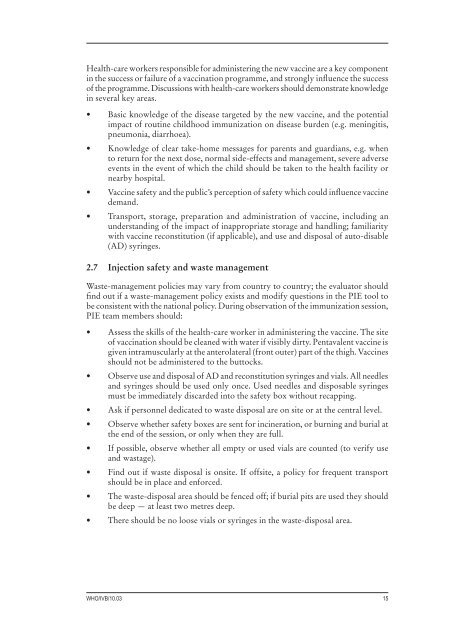New Vaccine Post-Introduction Evaluation - libdoc.who.int - World ...
New Vaccine Post-Introduction Evaluation - libdoc.who.int - World ...
New Vaccine Post-Introduction Evaluation - libdoc.who.int - World ...
You also want an ePaper? Increase the reach of your titles
YUMPU automatically turns print PDFs into web optimized ePapers that Google loves.
Health-care workers responsible for administering the new vaccine are a key component<br />
in the success or failure of a vaccination programme, and strongly influence the success<br />
of the programme. Discussions with health-care workers should demonstrate knowledge<br />
in several key areas.<br />
•<br />
•<br />
•<br />
•<br />
Basic knowledge of the disease targeted by the new vaccine, and the potential<br />
impact of routine childhood immunization on disease burden (e.g. meningitis,<br />
pneumonia, diarrhoea).<br />
Knowledge of clear take-home messages for parents and guardians, e.g. when<br />
to return for the next dose, normal side-effects and management, severe adverse<br />
events in the event of which the child should be taken to the health facility or<br />
nearby hospital.<br />
<strong>Vaccine</strong> safety and the public’s perception of safety which could influence vaccine<br />
demand.<br />
Transport, storage, preparation and administration of vaccine, including an<br />
understanding of the impact of inappropriate storage and handling; familiarity<br />
with vaccine reconstitution (if applicable), and use and disposal of auto-disable<br />
(AD) syringes.<br />
2.7 Injection safety and waste management<br />
Waste-management policies may vary from country to country; the evaluator should<br />
find out if a waste-management policy exists and modify questions in the PIE tool to<br />
be consistent with the national policy. During observation of the immunization session,<br />
PIE team members should:<br />
• Assess the skills of the health-care worker in administering the vaccine. The site<br />
of vaccination should be cleaned with water if visibly dirty. Pentavalent vaccine is<br />
given <strong>int</strong>ramuscularly at the anterolateral (front outer) part of the thigh. <strong>Vaccine</strong>s<br />
should not be administered to the buttocks.<br />
• Observe use and disposal of AD and reconstitution syringes and vials. All needles<br />
and syringes should be used only once. Used needles and disposable syringes<br />
must be immediately discarded <strong>int</strong>o the safety box without recapping.<br />
•<br />
Ask if personnel dedicated to waste disposal are on site or at the central level.<br />
• Observe whether safety boxes are sent for incineration, or burning and burial at<br />
the end of the session, or only when they are full.<br />
• If possible, observe whether all empty or used vials are counted (to verify use<br />
and wastage).<br />
• Find out if waste disposal is onsite. If offsite, a policy for frequent transport<br />
should be in place and enforced.<br />
• The waste-disposal area should be fenced off; if burial pits are used they should<br />
be deep — at least two metres deep.<br />
• There should be no loose vials or syringes in the waste-disposal area.<br />
WHO/IVB/10.03<br />
15

















